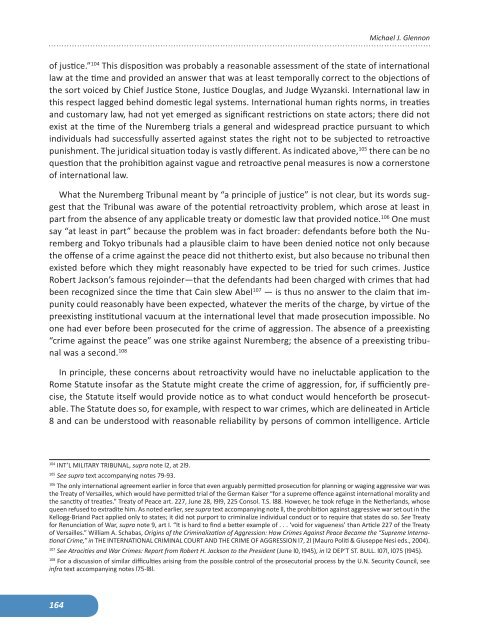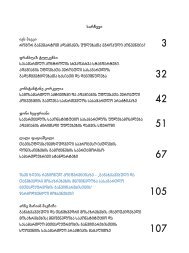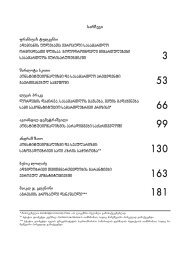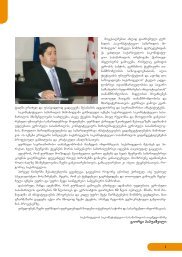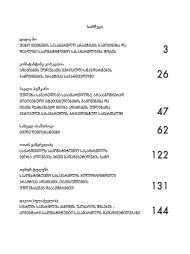Contents - Constitutional Court of Georgia
Contents - Constitutional Court of Georgia
Contents - Constitutional Court of Georgia
You also want an ePaper? Increase the reach of your titles
YUMPU automatically turns print PDFs into web optimized ePapers that Google loves.
164<br />
Michael J. Glennon<br />
<strong>of</strong> justice.” 104 This disposition was probably a reasonable assessment <strong>of</strong> the state <strong>of</strong> international<br />
law at the time and provided an answer that was at least temporally correct to the objections <strong>of</strong><br />
the sort voiced by Chief Justice Stone, Justice Douglas, and Judge Wyzanski. International law in<br />
this respect lagged behind domestic legal systems. International human rights norms, in treaties<br />
and customary law, had not yet emerged as significant restrictions on state actors; there did not<br />
exist at the time <strong>of</strong> the Nuremberg trials a general and widespread practice pursuant to which<br />
individuals had successfully asserted against states the right not to be subjected to retroactive<br />
punishment. The juridical situation today is vastly different. As indicated above, 105 there can be no<br />
question that the prohibition against vague and retroactive penal measures is now a cornerstone<br />
<strong>of</strong> international law.<br />
What the Nuremberg Tribunal meant by “a principle <strong>of</strong> justice” is not clear, but its words suggest<br />
that the Tribunal was aware <strong>of</strong> the potential retroactivity problem, which arose at least in<br />
part from the absence <strong>of</strong> any applicable treaty or domestic law that provided notice. 106 One must<br />
say “at least in part” because the problem was in fact broader: defendants before both the Nuremberg<br />
and Tokyo tribunals had a plausible claim to have been denied notice not only because<br />
the <strong>of</strong>fense <strong>of</strong> a crime against the peace did not thitherto exist, but also because no tribunal then<br />
existed before which they might reasonably have expected to be tried for such crimes. Justice<br />
Robert Jackson’s famous rejoinder—that the defendants had been charged with crimes that had<br />
been recognized since the time that Cain slew Abel 107 — is thus no answer to the claim that impunity<br />
could reasonably have been expected, whatever the merits <strong>of</strong> the charge, by virtue <strong>of</strong> the<br />
preexisting institutional vacuum at the international level that made prosecution impossible. No<br />
one had ever before been prosecuted for the crime <strong>of</strong> aggression. The absence <strong>of</strong> a preexisting<br />
“crime against the peace” was one strike against Nuremberg; the absence <strong>of</strong> a preexisting tribunal<br />
was a second. 108<br />
In principle, these concerns about retroactivity would have no ineluctable application to the<br />
Rome Statute ins<strong>of</strong>ar as the Statute might create the crime <strong>of</strong> aggression, for, if sufficiently precise,<br />
the Statute itself would provide notice as to what conduct would henceforth be prosecutable.<br />
The Statute does so, for example, with respect to war crimes, which are delineated in Article<br />
8 and can be understood with reasonable reliability by persons <strong>of</strong> common intelligence. Article<br />
104 INT’L MILITARY TRIBUNAL, supra note l2, at 2l9.<br />
105 See supra text accompanying notes 79-93.<br />
106 The only international agreement earlier in force that even arguably permitted prosecution for planning or waging aggressive war was<br />
the Treaty <strong>of</strong> Versailles, which would have permitted trial <strong>of</strong> the German Kaiser “for a supreme <strong>of</strong>fence against international morality and<br />
the sanctity <strong>of</strong> treaties.” Treaty <strong>of</strong> Peace art. 227, June 28, l9l9, 225 Consol. T.S. l88. However, he took refuge in the Netherlands, whose<br />
queen refused to extradite him. As noted earlier, see supra text accompanying note ll, the prohibition against aggressive war set out in the<br />
Kellogg-Briand Pact applied only to states; it did not purport to criminalize individual conduct or to require that states do so. See Treaty<br />
for Renunciation <strong>of</strong> War, supra note 9, art I. “It is hard to find a better example <strong>of</strong> . . . ‘void for vagueness’ than Article 227 <strong>of</strong> the Treaty<br />
<strong>of</strong> Versailles.” William A. Schabas, Origins <strong>of</strong> the Criminalization <strong>of</strong> Aggression: How Crimes Against Peace Became the “Supreme International<br />
Crime,” in THE INTERNATIONAL CRIMINAL COURT AND THE CRIME OF AGGRESSION l7, 2l (Mauro Politi & Giuseppe Nesi eds., 2004).<br />
107 See Atrocities and War Crimes: Report from Robert H. Jackson to the President (June l0, l945), in l2 DEP’T ST. BULL. l07l, l075 (l945).<br />
108 For a discussion <strong>of</strong> similar difficulties arising from the possible control <strong>of</strong> the prosecutorial process by the U.N. Security Council, see<br />
infra text accompanying notes l75-l8l.


